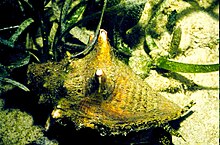
Back Розов стромбус Bulgarian Lobatus gigas CEB Křídlatec velký Czech Große Fechterschnecke German Lobatus gigas Spanish Jättiläissiipikotilo Finnish Lobatus gigas French Lanbi HT Vívócsiga Hungarian Siput gonggong ratu ID
| Aliger gigas | |
|---|---|

| |
| A live subadult individual of Aliger gigas, in situ surrounded by turtle grass | |

| |
| A dorsal view of an adult individual of A. gigas from Chenu, 1844 | |
| Scientific classification | |
| Domain: | Eukaryota |
| Kingdom: | Animalia |
| Phylum: | Mollusca |
| Class: | Gastropoda |
| Subclass: | Caenogastropoda |
| Order: | Littorinimorpha |
| Family: | Strombidae |
| Genus: | Aliger |
| Species: | A. gigas
|
| Binomial name | |
| Aliger gigas | |
| Synonyms[10] | |
|
Strombus gigas Linnaeus, 1758[3] | |
Aliger gigas, originally known as Strombus gigas or more recently as Lobatus gigas, commonly known as the queen conch, is a species of large sea snail, a marine gastropod mollusc in the family of true conches, the Strombidae. This species is one of the largest molluscs native to the Caribbean Sea, and tropical northwestern Atlantic, from Bermuda to Brazil, reaching up to 35.2 centimetres (13.9 in) in shell length. A. gigas is closely related to the goliath conch, Lobatus goliath, a species endemic to Brazil, as well as the rooster conch, Aliger gallus.
The queen conch is herbivorous. It feeds by browsing for plant and algal material growing in the seagrass beds, and scavenging for decaying plant matter. These large sea snails typically reside in seagrass beds, which are sandy plains covered in swaying sea grass and associated with coral reefs, although the exact habitat of this species varies according to developmental age. The adult animal has a very large, solid and heavy shell, with knob-like spines on the shoulder, a flared, thick outer lip, and a characteristic pink or orange aperture (opening). The outside of the queen conch is sandy colored, helping them blend in with their surroundings. The flared lip is absent in juveniles; it develops once the snail reaches reproductive age. The thicker the shell's flared lip is, the older the conch is.[11] The external anatomy of the soft parts of A. gigas is similar to that of other snails in the family Strombidae; it has a long snout, two eyestalks with well-developed eyes, additional sensory tentacles, a strong foot and a corneous, sickle-shaped operculum.
The shell and soft parts of living A. gigas serve as a home to several different kinds of commensal animals, including slipper snails, porcelain crabs and a specialized species of cardinalfish known as the conchfish Astrapogon stellatus. Its parasites include coccidians. The queen conch's natural predators include several species of large predatory sea snails, octopus, starfish, crustaceans and vertebrates (fish, sea turtles, nurse sharks). It is an especially important food source for large predators like sea turtles and nurse sharks. Human capture and consumption date back into prehistory.
Its shell is sold as a souvenir and used as a decorative object. Historically, Native Americans and indigenous Caribbean peoples used parts of the shell to create various tools.
International trade in the Caribbean queen conch is regulated under the Convention on International Trade in Endangered Species of Wild Fauna and Flora (CITES) agreement, in which it is listed as Strombus gigas.[12] This species is not endangered in the Caribbean as a whole, but is commercially threatened in numerous areas, largely due to extreme overfishing.
- ^ "NatureServe Explorer 2.0". explorer.natureserve.org. Retrieved 19 October 2022.
- ^ "Appendices | CITES". cites.org. Retrieved 14 January 2022.
- ^ Linnaeus, C. (1758). Systema Naturae, 10th ed., vol. 1. 824 pp. Laurentii Salvii: Holmiae (Stockholm, Sweden). p. 745.
- ^ Cite error: The named reference
PetCen2was invoked but never defined (see the help page). - ^ Clench, W. J. (1937). "Descriptions of new land and marine shells from the Bahama Islands." Proceedings of the New England Zoölogical Club 16: 17–26, pl. 1. (Stated date: 5 February 1937.) On pages 18–21, plate 1 figure 1.
- ^ Smith, M. (1940). World Wide Seashells: illustrations, geographical range and other data covering more than sixteen hundred species and sub-species of molluscs (1 ed.). Lantana, Florida: Tropical Photographic Laboratory. pp. 131, 139.
- ^ McGinty, T. L. (1946). "A new Florida Strombus, S. gigas verrilli". The Nautilus 60: 46–48, plates. 5–6: plate 5, figs. 2–3; plate 6, figs. 7–8.
- ^ Burry, L. A. (1949). "Shell Notes". Vol. 2. pp. 106–109.
- ^ Petuch, E. J. (1994). Atlas of Florida Fossil Shells. Chicago Spectrum Press: Evanston, Illinois., xii + 394 pp., 100 pls. On page 82, plate 20: figure c.
- ^ Rosenberg, G. (2009). "Eustrombus gigas (Linnaeus, 1758)". Malacolog Version 4.1.1: A Database of Western Atlantic Marine Mollusca. Retrieved 27 September 2009.
- ^ "Queen Conch".
- ^ Acosta, Charles C. (2006). "Impending Trade Suspensions of Caribbean Queen Conch under CITES: A Case Study on Fishery Impacts and Potential for Stock Recovery" (PDF). Fisheries. 32 (12): 601–606. doi:10.1577/1548-8446(2006)31[601:ITSOCQ]2.0.CO;2.
© MMXXIII Rich X Search. We shall prevail. All rights reserved. Rich X Search
